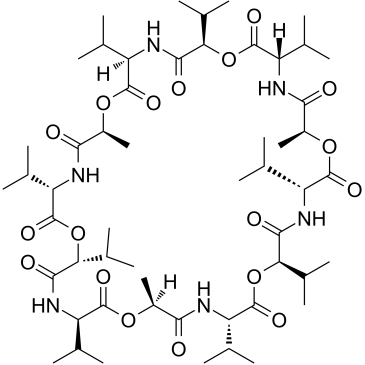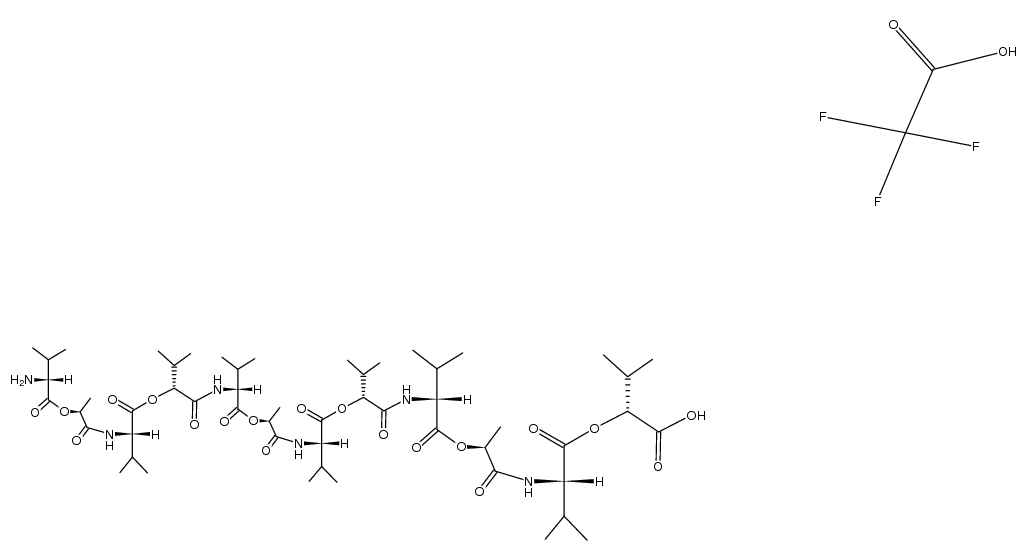Valinomycin

Valinomycin structure
|
Common Name | Valinomycin | ||
|---|---|---|---|---|
| CAS Number | 2001-95-8 | Molecular Weight | 1111.322 | |
| Density | 1.1±0.1 g/cm3 | Boiling Point | 1333.9±65.0 °C at 760 mmHg | |
| Molecular Formula | C54H90N6O18 | Melting Point | 186-190ºC | |
| MSDS | Chinese USA | Flash Point | 760.5±34.3 °C | |
| Symbol |

GHS06 |
Signal Word | Danger | |
Use of ValinomycinValinomycin (NSC 122023) is a cyclic depsipeptide antibiotic first isolated from Streptomyces fulvissimus, act as a potassium selective ionophore. Valinomycin (NSC 122023) inhibits lymphocyte proliferation by its effects on the cell membrane, and induces apoptosis in CHO cells[1]. |
| Name | valinomycin |
|---|---|
| Synonym | More Synonyms |
| Description | Valinomycin (NSC 122023) is a cyclic depsipeptide antibiotic first isolated from Streptomyces fulvissimus, act as a potassium selective ionophore. Valinomycin (NSC 122023) inhibits lymphocyte proliferation by its effects on the cell membrane, and induces apoptosis in CHO cells[1]. |
|---|---|
| Related Catalog | |
| References |
| Density | 1.1±0.1 g/cm3 |
|---|---|
| Boiling Point | 1333.9±65.0 °C at 760 mmHg |
| Melting Point | 186-190ºC |
| Molecular Formula | C54H90N6O18 |
| Molecular Weight | 1111.322 |
| Flash Point | 760.5±34.3 °C |
| Exact Mass | 1110.631104 |
| PSA | 332.40000 |
| LogP | -2.08 |
| Vapour Pressure | 0.0±0.3 mmHg at 25°C |
| Index of Refraction | 1.449 |
| Storage condition | 2~8°C |
Synonym:None Known Section 2 - COMPOSITION, INFORMATION ON INGREDIENTS
Risk Phrases: 27/28 Section 3 - HAZARDS IDENTIFICATION EMERGENCY OVERVIEW
Very toxic in contact with skin and if swallowed.Highly toxic. Potential Health Effects Eye: May cause eye irritation. Skin: May cause skin irritation. May be fatal if absorbed through the skin. Ingestion: May be fatal if swallowed. May cause irritation of the digestive tract. May cause cardiac disturbances. May cause central nervous system depression. Inhalation: May cause respiratory tract irritation. May cause cardiac abnormalities. Inhalation at high concentrations may cause CNS depression and asphixiation. Chronic: Effects may be delayed. Section 4 - FIRST AID MEASURES Eyes: Immediately flush eyes with plenty of water for at least 15 minutes, occasionally lifting the upper and lower eyelids. Get medical aid. Skin: Get medical aid immediately. Immediately flush skin with plenty of water for at least 15 minutes while removing contaminated clothing and shoes. Wash clothing before reuse. SPEEDY ACTION IS CRITICAL! Ingestion: Never give anything by mouth to an unconscious person. Get medical aid immediately. SPEED IS ESSENTIAL. A DOCTOR MUST BE NOTIFIED AT ONCE. Do NOT induce vomiting. If conscious and alert, rinse mouth and drink 2-4 cupfuls of milk or water. Inhalation: Get medical aid immediately. Remove from exposure and move to fresh air immediately. If breathing is difficult, give oxygen. Do NOT use mouth-to-mouth resuscitation. If breathing has ceased apply artificial respiration using oxygen and a suitable mechanical device such as a bag and a mask. Notes to Physician: Section 5 - FIRE FIGHTING MEASURES General Information: As in any fire, wear a self-contained breathing apparatus in pressure-demand, MSHA/NIOSH (approved or equivalent), and full protective gear. During a fire, irritating and highly toxic gases may be generated by thermal decomposition or combustion. Containers may explode when heated. Non-combustible, substance itself does not burn but may decompose upon heating to produce irritating, corrosive and/or toxic fumes. Extinguishing Media: Substance is noncombustible; use agent most appropriate to extinguish surrounding fire. Section 6 - ACCIDENTAL RELEASE MEASURES General Information: Use proper personal protective equipment as indicated in Section 8. Spills/Leaks: Vacuum or sweep up material and place into a suitable disposal container. Clean up spills immediately, observing precautions in the Protective Equipment section. Avoid generating dusty conditions. Provide ventilation. Section 7 - HANDLING and STORAGE Handling: Wash thoroughly after handling. Use with adequate ventilation. Minimize dust generation and accumulation. Avoid contact with eyes, skin, and clothing. Keep container tightly closed. Avoid ingestion and inhalation. Storage: Store in a tightly closed container. Store in a cool, dry, well-ventilated area away from incompatible substances. Poison room locked/refrigerator. Section 8 - EXPOSURE CONTROLS, PERSONAL PROTECTION Engineering Controls: Facilities storing or utilizing this material should be equipped with an eyewash facility and a safety shower. Use adequate ventilation to keep airborne concentrations low. Exposure Limits CAS# 2001-95-8: Personal Protective Equipment Eyes: Wear appropriate protective eyeglasses or chemical safety goggles as described by OSHA's eye and face protection regulations in 29 CFR 1910.133 or European Standard EN166. Skin: Wear appropriate protective gloves to prevent skin exposure. Clothing: Wear appropriate protective clothing to minimize contact with skin. Respirators: Follow the OSHA respirator regulations found in 29 CFR 1910.134 or European Standard EN 149. Use a NIOSH/MSHA or European Standard EN 149 approved respirator if exposure limits are exceeded or if irritation or other symptoms are experienced. Section 9 - PHYSICAL AND CHEMICAL PROPERTIES Physical State: Solid Color: white Odor: None reported. pH: Not available. Vapor Pressure: Not available. Viscosity: Not available. Boiling Point: Not available. Freezing/Melting Point: 187.00 - 189.00 deg C Autoignition Temperature: Not applicable. Flash Point: Not applicable. Explosion Limits, lower: Not available. Explosion Limits, upper: Not available. Decomposition Temperature: Solubility in water: practically insoluble Specific Gravity/Density: Molecular Formula: C54H90N6O18 Molecular Weight: 1111.35 Section 10 - STABILITY AND REACTIVITY Chemical Stability: Stable under normal temperatures and pressures. Conditions to Avoid: Incompatible materials, dust generation, excess heat, strong oxidants. Incompatibilities with Other Materials: Oxidizing agents. Hazardous Decomposition Products: Carbon monoxide, irritating and toxic fumes and gases, carbon dioxide. Hazardous Polymerization: Has not been reported. Section 11 - TOXICOLOGICAL INFORMATION RTECS#: CAS# 2001-95-8: YV9468000 LD50/LC50: CAS# 2001-95-8: Oral, mouse: LD50 = 2500 ug/kg; Oral, rat: LD50 = 4 mg/kg; Skin, rabbit: LD50 = 5 mg/kg. Carcinogenicity: Valinomycin - Not listed by ACGIH, IARC, or NTP. Other: See actual entry in RTECS for complete information. Section 12 - ECOLOGICAL INFORMATION Section 13 - DISPOSAL CONSIDERATIONS Dispose of in a manner consistent with federal, state, and local regulations. Section 14 - TRANSPORT INFORMATION IATA Shipping Name: TOXIC SOLID, ORGANIC, N.O.S.* Hazard Class: 6.1 UN Number: 2811 Packing Group: I IMO Shipping Name: TOXIC SOLID, ORGANIC, N.O.S. Hazard Class: 6.1 UN Number: 2811 Packing Group: I RID/ADR Shipping Name: TOXIC SOLID, ORGANIC, N.O.S. Hazard Class: 6.1 UN Number: 2811 Packing group: I Section 15 - REGULATORY INFORMATION European/International Regulations European Labeling in Accordance with EC Directives Hazard Symbols: T+ Risk Phrases: R 27/28 Very toxic in contact with skin and if swallowed. Safety Phrases: S 26 In case of contact with eyes, rinse immediately with plenty of water and seek medical advice. S 45 In case of accident or if you feel unwell, seek medical advice immediately (show the label where possible). WGK (Water Danger/Protection) CAS# 2001-95-8: 3 Canada CAS# 2001-95-8 is listed on Canada's NDSL List. CAS# 2001-95-8 is not listed on Canada's Ingredient Disclosure List. US FEDERAL TSCA CAS# 2001-95-8 is listed on the TSCA inventory. SECTION 16 - ADDITIONAL INFORMATION N/A |
CHEMICAL IDENTIFICATION
HEALTH HAZARD DATAACUTE TOXICITY DATA
|
| Symbol |

GHS06 |
|---|---|
| Signal Word | Danger |
| Hazard Statements | H300 + H310 |
| Precautionary Statements | P264-P280-P301 + P310-P302 + P350-P310 |
| Personal Protective Equipment | Eyeshields;Faceshields;full-face particle respirator type N100 (US);Gloves;respirator cartridge type N100 (US);type P1 (EN143) respirator filter;type P3 (EN 143) respirator cartridges |
| Hazard Codes | Xn: Harmful; |
| Risk Phrases | R27/28 |
| Safety Phrases | S28;S45;S36/S37 |
| RIDADR | UN 2811 6 |
| WGK Germany | 3 |
| RTECS | YV9468000 |
| Hazard Class | 6.1(a) |
|
~% 
Valinomycin CAS#:2001-95-8 |
| Literature: Zeggaf, Choukri; Poncet, Joel; Jouin, Patrick; Dufour, Marie-Noelle; Castro, Bertrand Tetrahedron, 1989 , vol. 45, # 16 p. 5039 - 5050 |
| Precursor 1 | |
|---|---|
| DownStream 0 | |
|
Fast synthesis of platinum nanopetals and nanospheres for highly-sensitive non-enzymatic detection of glucose and selective sensing of ions.
Sci. Rep. 5 , 15277, (2015) Novel methods to obtain Pt nanostructured electrodes have raised particular interest due to their high performance in electrochemistry. Several nanostructuration methods proposed in the literature use... |
|
|
Characterization of pressurized hot water extracts of grape pomace: chemical and biological antioxidant activity.
Food Chem. 171 , 62-9, (2014) Pressurized hot water extracts obtained at different temperatures possess different compositions and antioxidant activities and, consequently, different bioactivities. We characterized two pressurized... |
|
|
Role of polyol moiety of amphotericin B in ion channel formation and sterol selectivity in bilayer membrane.
Bioorg. Med. Chem. 23 , 5782-8, (2015) Amphotericin B (AmB) is a polyene macrolide antibiotic widely used to treat mycotic infections. In this paper, we focus on the role of the polyol moiety of AmB in sterol selectivity using 7-oxo-AmB, 7... |
| (3S,6S,9R,12R,15S,18S,21R,24R,27S,30S,33R,36R)-6,18,30-trimethyl-3,9,12,15,21,24,27,33,36-nona(propan-2-yl)-1,7,13,19,25,31-hexaoxa-4,10,16,22,28,34-hexaazacyclohexatriacontane-2,5,8,11,14,17,20,23,26,29,32,35-dodecone |
| Valinomycin |
| antibioticn-329b |
| valinomicin |
| 1,7,13,19,25,31-Hexaoxa-4,10,16,22,28,34-hexaazacyclohexatriacontane-2,5,8,11,14,17,20,23,26,29,32,35-dodecone, 6,18,30-trimethyl-3,9,12,15,21,24,27,33,36-nonakis(1-methylethyl)-, (3S,6S,9R,12R,15S,18S,21R,24R,27S,30S,33R,36R)- |
| EINECS 217-896-6 |
| Valinomycin,Cyclo(D-α-hydroxyisovaleryl-D-valyl-L-lactoyl-L-valyl-D-α-hydroxyisovaleryl-D-valyl-L-lactoyl-L-valyl-D-α-hydroxyisovaleryl-D-valyl-L-lactoyl-L-valyl) |
| Cyclo(D-α-hydroxyisovaleryl-D-valyl-L-lactoyl-L-valyl-D-α-hydroxyisovaleryl-D-valyl-L-lactoyl-L-valyl-D-α-hydroxyisovaleryl-D-valyl-L-lactoyl-L-valyl) |
| (3R,6R,9S,12S,15R,18R,21S,24S,27R,30R,33S,36S)-3,6,9,15,18,21,27,30,33-Nonaisopropyl-12,24,36-trimethyl-1,7,13,19,25,31-hexaoxa-4,10,16,22,28,34-hexaazacyclohexatriacontane-2,5,8,11,14,17,20,23,26,29,32,35-dodecone |
| BU 226 hydrochloride |
| Cyclo(D-a-hydroxyisovaleryl-D-valyl-L-lactoyl-L-valyl-D-a-hydroxyisovaleryl-D-valyl-L-lactoyl-L-valyl-D-a-hydroxyisovaleryl-D-valyl-L-lactoyl-L-valyl) |
| MFCD00005114 |


